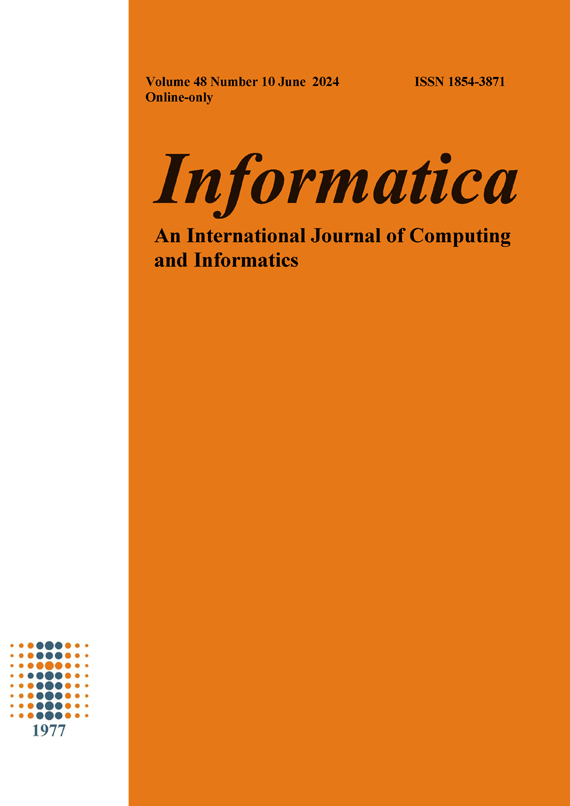Formation Control Algorithm for Multiple Mobile Robots BasedonFuzzy Mathematics
DOI:
https://doi.org/10.31449/inf.v48i10.5737Abstract
The formation of multiple mobile robots has problems such as unsmooth formationtrajectory tracking and large formation control errors. To solve these problems, a three closed-loopsliding mode formation control method is proposed, which can achieve stable three closed-loopcontrol systems from both linear and angular velocity directions. At the same time, fuzzy theory isintroduced to design a fuzzy sliding mode control model for multiple mobile robots, which canmake the gain switching more smooth, and solve the problem of unsmooth and interference intrajectory tracking. The results showed that the linear velocity fluctuation of the research designedmodel was controlled within 5 seconds, and the angular velocity fluctuation was controlled within1 second. The overall mean value of position control indicators was 17.08, which was smaller thanthe comparison model. The average value of the position speed comprehensive control index was2.8, which was smaller than the comparison model. The research and design model had highercontrol accuracy and more stable control effects, ensuring the efficient and high-quality executionof tasks by robots, and can provide a technical basis for the formation motion control of multiplemobile robots.References
Guan J, Zhou W, Kang S, Sun Y, Liu Z. Robot formation control based on internet of thingstechnology platform. IEEE Access, 2020, 8: 96767-96776. [2] Koung D, Kermorgant O, Fantoni I, Belouaer L. Cooperative multi-robot object transportationsystem based on hierarchical quadratic programming. IEEE Robotics and Automation Letters, 2021, 6(4): 6466-6472. [3] Lu P, Wang H, Zhang F, Yu W, Chen G. Formation control of nonholonomic mobile robotsusing distributed estimators. IEEE Transactions on Circuits and Systems II: Express Briefs, 2020,67(12): 3162-3166. [4] Yin H, Guo S, Liu M. A virtual linkage-based dual event-triggered formation control strategyfor multiple amphibious spherical robots in constrained space with limited communication. IEEESensors Journal, 2022, 22(13): 13395-13406. [5] Kamel M A, Yu X, Zhang Y. Formation control and coordination of multiple unmanned groundvehicles in normal and faulty situations: A review. Annual Reviews in Control, 2020, 49: 128-144. [6] Dong X, Sitti M. Controlling two-dimensional collective formation and cooperative behaviorof magnetic microrobot swarms. The International Journal of Robotics Research, 2020, 39(5):617-638. [7] Fu W, Qin J, Zheng W X, Chen Y, Kang Y. Resilient cooperative source seeking ofdouble-integrator multi-robot systems under deception attacks. IEEE Transactions on IndustrialElectronics, 2020, 68(5): 4218-4227. [8] Hu J, Bhowmick P, Lanzon A. Group coordinated control of networked mobile robots withapplications to object transportation. IEEE Transactions on Vehicular Technology, 2021, 70(8):8269-8274. [9] Asai R, Sakurama K. Cooperative reference frame estimation for multi-agent systems viaformation control. Advanced Robotics, 2023, 37(3): 198-209. [10] Liu D, Zong C, Wang D, Zhao W, Wang Y, Lu W. Multi-robot formation control based onhigh-order bilateral consensus. Measurement and Control, 2020, 53(5-6): 983-993. [11] Khalaji A K, Zahedifar R. Lyapunov-based formation control of underwater robots. Robotica, 2020, 38(6): 1105-1122. [12] Dai S L, Lu K, Fu J. Adaptive finite-time tracking control of nonholonomic multirobotformation systems with limited field-of-view sensors. IEEE Transactions on Cybernetics, 2021, 52(10): 10695-10708. [13] Kamel M A, Yu X, Zhang Y. Formation control and coordination of multiple unmannedground vehicles in normal and faulty situations: A review. Annual Reviews in Control, 2020, 49:128-144. [14] Hu J, Bhowmick P, Jang I, Arvin F, Lanzon A. A decentralized cluster formation containmentframework for multirobot systems. IEEE Transactions on Robotics, 2021, 37(6): 1936-1955. [15] Qu S, Zhao L, Xiong Z. Cross-layer congestion control of wireless sensor networks based onfuzzy sliding mode control. Neural Computing and Applications, 2020, 32: 13505-13520. [16] Fei J, Wang Z, Liang X, Feng Z, Xue Y. Fractional sliding-mode control for microgyroscopebased on multilayer recurrent fuzzy neural network. IEEE Transactions on Fuzzy Systems, 2021, 30(6): 1712-1721. [17] Li J, Wang J, Peng H, Hu Y, Su H. Fuzzy-torque approximation-enhanced sliding modecontrol for lateral stability of mobile robot. IEEE Transactions on Systems, Man, and Cybernetics:Systems, 2021, 52(4): 2491-2500. [18] Teng L, Gull M A, Bai S. PD-based fuzzy sliding mode control of a wheelchair exoskeletonrobot. IEEE/ASME Transactions on Mechatronics, 2020, 25(5): 2546-2555. [19] Cao Z, Niu Y, Lam H K, Zhao J. Sliding mode control of Markovian jump fuzzy systems: Adynamic event-triggered method. IEEE Transactions on Fuzzy Systems, 2020, 29(10): 2902-2915.
Downloads
Published
Issue
Section
License
I assign to Informatica, An International Journal of Computing and Informatics ("Journal") the copyright in the manuscript identified above and any additional material (figures, tables, illustrations, software or other information intended for publication) submitted as part of or as a supplement to the manuscript ("Paper") in all forms and media throughout the world, in all languages, for the full term of copyright, effective when and if the article is accepted for publication. This transfer includes the right to reproduce and/or to distribute the Paper to other journals or digital libraries in electronic and online forms and systems.
I understand that I retain the rights to use the pre-prints, off-prints, accepted manuscript and published journal Paper for personal use, scholarly purposes and internal institutional use.
In certain cases, I can ask for retaining the publishing rights of the Paper. The Journal can permit or deny the request for publishing rights, to which I fully agree.
I declare that the submitted Paper is original, has been written by the stated authors and has not been published elsewhere nor is currently being considered for publication by any other journal and will not be submitted for such review while under review by this Journal. The Paper contains no material that violates proprietary rights of any other person or entity. I have obtained written permission from copyright owners for any excerpts from copyrighted works that are included and have credited the sources in my article. I have informed the co-author(s) of the terms of this publishing agreement.
Copyright © Slovenian Society Informatika








